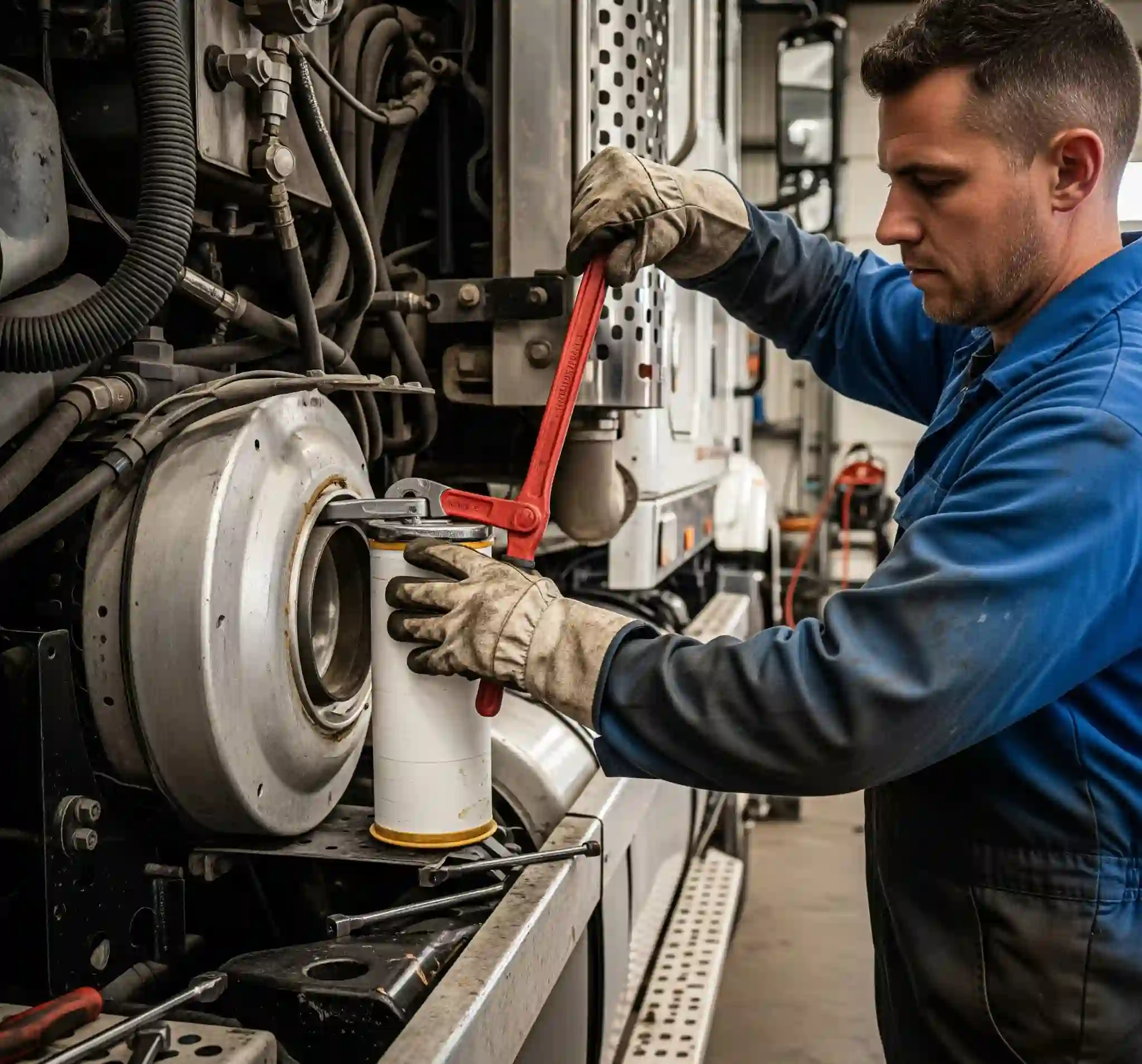
The Lifeblood of a Safe Stop A Deep Dive into Air Brake Components and the Critical Air Dryer
The hiss of an air brake system is one of the most iconic sounds of American industry. It’s the sound of power under control, the signal that tons of steel and cargo are being brought to a safe, reliable stop. This system is a marvel of pneumatic engineering, but its long-term health and unwavering reliability depend on the quality of the air that flows through it. While we often think of the large, powerful components, the true guardian of the entire system is a smaller, often-overlooked hero: the air dryer.
At theamericantrucks.com, we know that safety and uptime are paramount. Understanding your air brake system isn’t just for mechanics; it’s for every driver and owner who depends on it. This guide will break down the essential air brake components and take a deep dive into the most critical protective device in the system, exploring the world of air dryers and parts.
A Quick Tour of the Air Brake System
Before we can appreciate the air dryer, we must understand the system it protects. An air brake system uses compressed air to apply immense force to the wheel brakes, far more than any hydraulic system could. The process is a chain of command involving several key components:
- The Air Compressor: The heart of the system. This engine-driven pump draws in outside air and compresses it to around 125-135 PSI.
- The Governor: The brain. It tells the compressor when to start pumping (cut-in pressure) and when to stop (cut-out pressure), maintaining the correct operating pressure.
- Air Tanks (Reservoirs): The lungs. These tanks store the compressed air, ensuring a ready supply for multiple brake applications.
- The Foot Valve (Treadle): Your command center. When you press the brake pedal, this valve releases a precise amount of air from the tanks and sends it down the line.
- Brake Chambers and Slack Adjusters: The muscle. The air pressure flows into the brake chambers, pushing on a diaphragm and a pushrod. This pushrod then turns the slack adjuster, which in turn rotates the S-cam to force the brake shoes against the drum, stopping the truck.
This entire network relies on one simple principle: a ready supply of clean, dry air. Unfortunately, the very act of compressing air creates its two worst enemies: water and oil.
The Enemy Within Moisture and Contamination
When the air compressor pressurizes ambient air, it also concentrates the water vapor naturally present in the atmosphere. As this hot, compressed air cools in the tanks, the water vapor condenses into liquid water—the arch-nemesis of an air brake system.
Without an effective defense, this moisture wreaks havoc:
- Internal Corrosion: Water causes rust to form inside air tanks, valves, and brake chambers. These rust particles can then break loose and travel through the system, clogging the tiny, sensitive passages inside expensive ABS modulator valves and relay valves, causing them to stick or fail.
- Freezing in Cold Weather: This is the most dangerous consequence. In freezing temperatures, accumulated water can turn to ice, completely blocking air lines or seizing valves. An iced-up brake valve can mean your brakes either won’t apply or, just as dangerously, won’t release.
- Lubricant Washout: Many valves rely on a thin film of special grease for smooth operation. Water can wash this lubricant away, causing premature wear and erratic valve performance.
Furthermore, the air compressor itself can introduce tiny droplets of oil into the air supply. This oily mist mixes with the water to form a thick, sticky sludge that coats the inside of the system, degrading the rubber seals and diaphragms in your valves and brake chambers, leading to premature failure and air leaks.
The Guardian of the System The Air Dryer
This is where the air dryer proves its worth. Placed in the system immediately after the air compressor, its sole job is to clean and dry the air before it reaches any other component. It is the first and most important line of defense.
How it Works: The Drying and Regeneration Cycle
The familiar, sharp “psssht” sound you hear from a truck every few minutes is the air dryer completing its work. The process is a brilliant two-part cycle.
- The Drying Cycle: Hot, moist, and slightly oily air is pumped from the compressor and enters the inlet of the air dryer. It is forced to travel up through a canister, or cartridge, filled with a desiccant material. Desiccant is a type of substance, usually in the form of small beads, that is highly porous and designed to adsorb moisture. As the air passes over millions of these beads, the water and oil vapor stick to them, effectively “drying” the air. The now clean, dry air exits the top of the dryer and flows to the supply tank.
- The Purge (Regeneration) Cycle: The compressor continues to run until the system pressure reaches the “cut-out” point. The governor then signals the compressor to unload and simultaneously sends an air signal to the purge valve at the bottom of the air dryer. This valve opens instantly, venting all the liquid water and oil that has been collected at the bottom. Crucially, a small volume of ultra-dry air stored in a dedicated purge tank (or back-fed from the supply tank) is sent backwards through the desiccant cartridge at high speed. This rapid back-flow strips the trapped moisture from the desiccant beads and blasts it out through the open purge valve. This is the loud purge sound you hear. This process regenerates the desiccant, preparing it for the next drying cycle.
A Deep Dive into Air Dryers and Parts
An air dryer is only as good as the components inside it. Proper maintenance means understanding and replacing these key air dryers and parts at regular intervals.
- The Desiccant Cartridge: This is the most critical service item. The desiccant material has a finite lifespan. Over time, it becomes so saturated with moisture and contaminated with oil that it can no longer be effectively regenerated. At this point, it stops trapping moisture and allows it to pass right through into your air system.
- Maintenance: For trucks in heavy-use or high-humidity applications (like vocational or refuse trucks), the cartridge should be replaced annually. For standard line-haul applications, replacement every 2 to 3 years is recommended.
- Coalescing vs. Standard Cartridges: A standard cartridge is good at removing water, but a coalescing cartridge is better. It contains an extra filter layer specifically designed to capture the fine aerosolized oil droplets from the compressor. If your compressor is showing signs of age, upgrading to a coalescing cartridge offers superior protection for the rest of your system.
- The Purge Valve Assembly: This valve is the workhorse of the dryer, opening and closing thousands of times. Its internal seals and pistons can wear out, leading to a constant, quiet hissing of air from the bottom of the dryer. This small leak makes your compressor work harder and wastes fuel. Thankfully, purge valve service kits are available to rebuild the valve without replacing the entire dryer.
- The Heater Assembly: For trucks operating in cold climates, most air dryers are equipped with a 12V or 24V heater. Its only job is to prevent the collected moisture at the bottom of the dryer and the purge valve itself from freezing solid. A failed heater is a common cause of wintertime brake system freeze-ups, as the dryer can no longer purge its collected water.
Troubleshooting Your Air Dryer
- Symptom: You drain your air tanks and find water. This is the number one sign your air dryer is not working. The desiccant cartridge is saturated and needs immediate replacement.
- Symptom: The dryer is not purging. This could be a faulty governor, a clogged or frozen signal line to the purge valve, or a seized purge valve.
- Symptom: You see oil spitting from the purge valve. This is a major red flag. It means your air compressor is failing and passing excessive amounts of oil. The air dryer is doing its job by catching it, but the root cause—the compressor—needs to be addressed before it contaminates the entire system.
Conclusion An Investment in Total System Health
Maintaining your air dryer is about so much more than servicing a single component. It’s about protecting the integrity of your entire air brake system. The cost of a new desiccant cartridge is a tiny fraction of the cost of a single ABS modulator valve or a complex electronic braking system ECU.
By committing to a proactive maintenance schedule and using high-quality air dryers and parts, you are making a direct investment in the safety, reliability, and longevity of your truck. Every safe stop begins with clean, dry air, and that journey starts at the air dryer.




